
The 'mushroom of immortality' and nourisher of the spirit, Reishi mushroom is revered for its ability to support a sense of calm while at the same time strengthen immunity and support the body's innate ability to handle stress.
Reishi has been used in Traditional Chinese Medicine for at least two thousand years with the original textbook of traditional Chinese medicine, The Shen Nong Ben Cao Jing written by 'The Divine Farmer' Shen Nong, ranking Reishi mushroom as a Superior Herb, highest among the 365 healing plants and fungi. This is the first known time Reishi appeared in written text, but the knowledge shared was based on even earlier oral tradition.
Reishi seems to carry with it an almost celestial quality and its enduring use as a spiritual aid and medicinal herb has been glorified throughout Chinese history in particular, immortalised through art, song, poetry, dance, architecture and jewellery to name a few[1].
The type of Reishi mushroom we work with is Red Reishi whose scientific name is Ganoderma Lucidum. During the Ming Dynasty, the Ben Cao Gang Mu (Compendium of Materia Medica) noted 6 different colours of Reishi Mushroom, the 6 Zhi (zhi often meaning mushroom or fungi). The colours identified are red, black, white, purple, green (sometimes referred to as blue reishi) and yellow and were related to the 5 Elements Theory in Traditional Chinese Medicine, with each colour being connected to an organ system within the body[2].
The Different Colours and Benefits of Reishi Mushroom as Described by the Ancients:
~ Red Reishi Heart
~ Black Reishi Kidneys
~ White Reishi Lungs
~ Green Reishi Liver
~ Yellow Reishi Spleen
~ Purple Reishi Occupies a space between the other 5 types.
Each of the different colours correspond to types of Reishi mushroom or Ganoderma that were said to have been commonly found across mountains and forests in ancient China. Different species of Reishi are thought to have varying levels of triterpenes and phenolic compounds along with branching patterns of beta-d-glucans, so the benefits from a healing perspective are thought to range. However, it’s worth noting that the colour of Reishi medicinal mushrooms can change depending on the season and weather conditions. For instance Red Reishi, has the ability to appear more orange or yellow in colour.
During the time in which the 6 different colours of Reishi were first described, around AD 1590, there were no scientific means of taxonomy available, leaving the existence of the legendary 6 Zhi up for debate and speculation as to which known, modern species of mushrooms the ancients could have been referred to. In reality, there are over 200 known species of Reishi[3], but only a proportionally small number have been scientifically studied.
While we may never know the true identity of the mythical 6 Zhi and whether or not true Reishi existed in a variety of colours, the following species are the most commonly accepted the species of medicinal mushrooms which relate to the 6 colours.
Red Reishi ~ Ganoderma Lucidum
At Inner Atlas, we work solely with Red Reishi, which is the most highly revered all of the species and considered to offer the most significant health enhancing-effects due to its high naturally occurring beta-d-glucan and active compound content[4]. Red Reishi has been extensively studied and is known to offer a wide range of benefits including; supporting healthy liver function, regulating the immune system, easing inflammation and protecting against free radicals, enhancing cognitive function, improving energy levels, relieving symptoms of anxiety and insomnia and benefitting the heart helping to regulate cholesterol and blood pressure.
Red Reishi’s traditional connection to the heart and the nervous system has long been valued to help calm the mind and spirit, promoting a relaxed state of focus, similar to a meditative state.
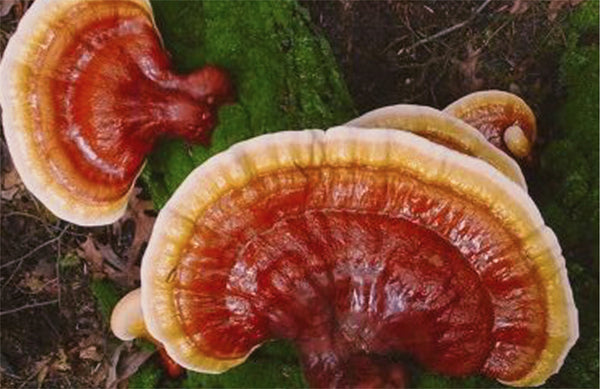
Black Reishi ~ Amauroderma Rugosum
Black Reishi is a member of the ganodermataceae family and is thought to help nourish the kidneys, reduce inflammation and soothe digestive discomfort[5]. It has a rich history as a folk remedy across Asia and the fresh mushrooms were traditionally used in Malaysia to form a necklace to help soothe distressed babies[6].
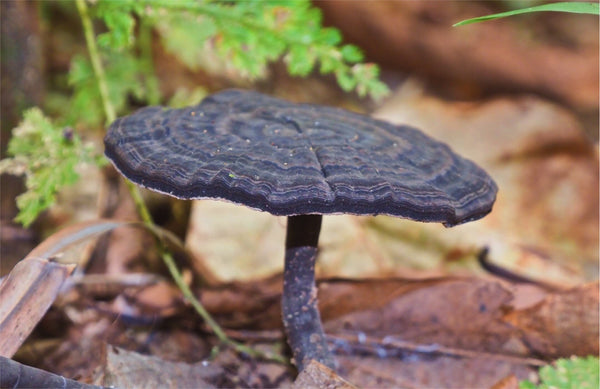
Purple Reishi ~ Ganoderma Sinensis
Out of the 6 colours of Reishi mushroom, Purple Reishi is considered to have similar healing benefits to Red Reishi, but is not regarded to be as potent due to its lower levels of bioactive compounds and beta-d-glucans[7]. It has a lighter taste compared to Red Reishi and is often used as an immune-supportive and anti-inflammatory mushroom. Commercially, it’s sometimes sold as Black Reishi, further adding to the confusion around the different types of Reishi!
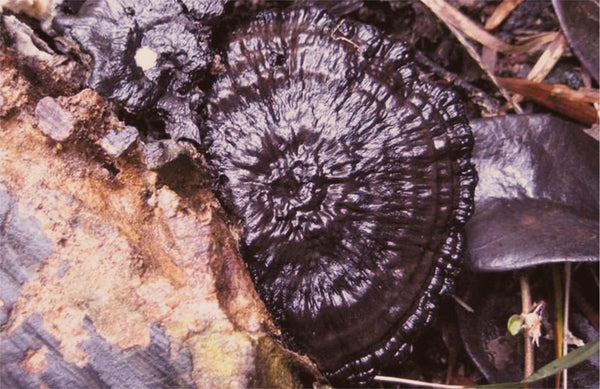
White Reishi ~ Laricifomes Officinalis
White Reishi or Agarikon is one of the earliest known medicines recorded in history, even dating back to Ancient Greece with physician Dioscorides referring to Agarikon as elixirium ad longam vitam, meaning the “elixir of long life"[8]. A research paper published in Planta Medica notes Agarikon has been traditionally used to treat conditions of the lungs, as a laxative, or as bitter to aid digestion[9].
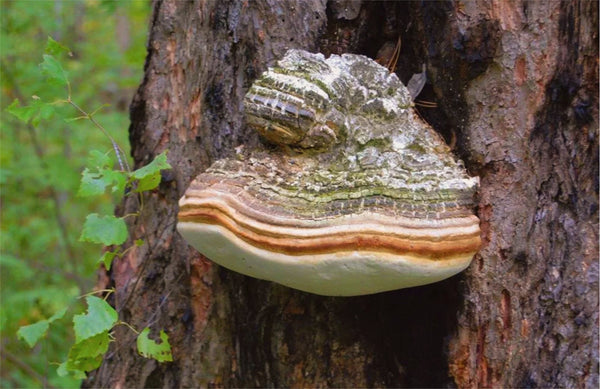
Green Reishi ~ Trametes Versicolor
If you’re a regular visitor to our site you’re not wrong in thinking you’ve seen Trametes Versicolor mentioned here before as it’s actually Turkey Tail! It’s obvious to us today that Turkey Tail is not part of the Ganoderma family, but you can see how the Ancients may have classed Turkey Tail as a Reishi variety as they are both polypores and bracket fungi meaning they have pores or tubes on the underside of their caps and grow in clusters from logs or trees to resemble a shelf. In its role as ‘Green Reishi' Turkey Tail does have liver-protecting properties according to its association with the 5 Elements Theory and so much more. It's supremely immune-supportive, gut nourishing, anti-inflammatory and antioxidant rich.
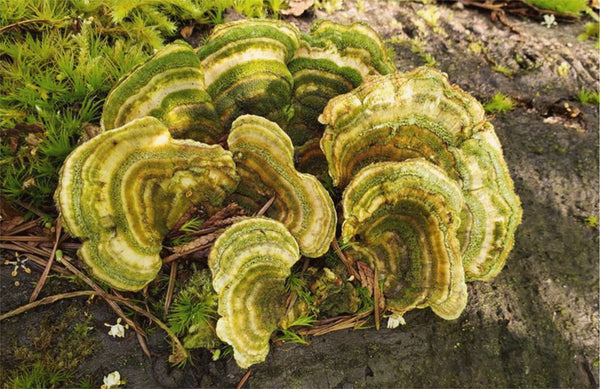
Yellow Reishi ~ Laetiporus Sulphureus
Laetiporus Sulphureus or Sulphur Shelf is often referred to as the Chicken of the Woods as it reportedly tastes like chicken. I can’t say we’ve ever tasted it, but we sure would love to! Again, this mushie is a bracket fungus and has a similar appearance to Reishi but it’s not a Ganoderma species. Sulphur Shelf is said to have a wide array of bioactive compounds and associated healing benefits including being anti-inflammatory and anti-microbial.
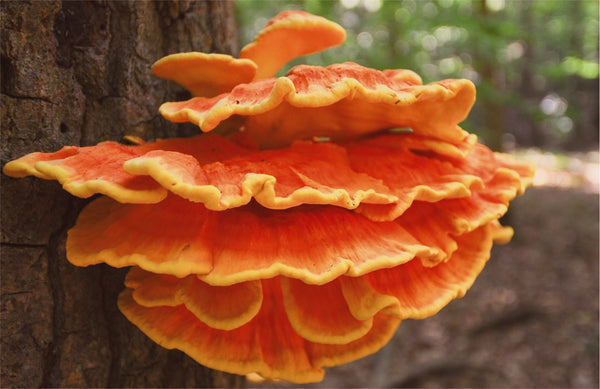
True Species of Reishi
Only 2 of the 6 colours are true Reishi, Red and Purple. But it just goes to show there’s still so much left to discover about the fungi kingdom even when we’re exploring a mushroom as ancient and well-known as our Queen Reishi.
Inner Atlas Red Reishi
We're proud to source our Inner Atlas Reishi from Jinzhai County, a Di Tao location which was recorded in The Divine Farmer's Materia Medica. Di Tao is the traditional Daoist practice of sourcing tonic herbs from their spiritual homeland or authentic place of origin. Our medicinal mushroom extracts are all sourced from pristine and remote Di Tao growing regions, where the individual mushrooms have been traditionally grown and are considered to produce the most potent mushrooms of that particular type. Plus, our Inner Atlas Reishi has a 20:1 extraction meaning 20 kg of mushrooms create 1kg of reishi powder, and contains greater than 30% beta-D-glucans (the active compounds) resulting in a more potent extract than many of the medicinal mushrooms you might find out there.
References:
[1] https://dixonnetworkingassociates.org/files/reishi.pdf
[2] https://www.christopherhobbs.com/news-archive/christopher-hobbss-medicinal-mushrooms-the-essential-guide/
[3] https://www.idosi.org/aejb/1(3)08/8.pdf
[4] https://www.idosi.org/aejb/1(3)08/8.pdf
[5] https://www.tandfonline.com/doi/abs/10.1080/00275514.2020.1851135?journalCode=umyc20
[6] https://www.dl.begellhouse.com/journals/708ae68d64b17c52,2dab30ba797125f4,509b6ce304abbdf5.html
[7] https://www.idosi.org/aejb/1(3)08/8.pdf
[8] https://www.goodnet.org/articles/introducing-5-benefits-agarikon-mushrooms
[9] https://www.thieme-connect.com/products/ejournals/html/10.1055/s-0036-1596557






